Geography Reference
In-Depth Information
Figure 8-2
Population density . Note the intense
concentration in the Ganges River
valley .
From H. J. de Blij and P . O. Muller,
Geography: Realms, Regions and Concepts
,
14th edition, 2010, p. 404. Originally
rendered in color. Reprinted with
permission of John Wiley & Sons, Inc.
SOUTH ASIA POPULATION
DISTRIBUTION: 2010
One dot represents 75,000 persons
0
0
400
s
r
250
500 Miles
70
°
Longitude East of Greenwich
90
°
Economic incentives were common; food rations
were withheld from some families with more than three
children; others lost a month' s pay unless a worker was
sterilized. Such programs are believed to have averted
more than 85 million births from 1956 to 1986. Even so,
progress was problematic.
Ethnic, religious, and caste rivalry fostered fears of
persecution and genocide, and violent resistance be-
came frequent. Capitalizing on these fears, politicians
were quick to blame family planning for other social ills.
Many organized programs have fallen by the wayside. I
recall visiting a village where a “two-child” poster had
been painted on the side of a school building. As the
children crowded around me, I noticed that the poster
was in a terrible state of disrepair. It was barely legible.
One boy jumped up, pointed at it, and said in English:
“Small family very funny .” Everyone laughed, the
teacher louder than anyone.
Fertility behavior is strongly influenced by prevailing
social and economic conditions as well as by religious/
cultural norms and expectations, such as early marriage.
Of the 4.5 million marriages each year, an estimated 3 mil-
lion brides are between 15 and 19 years old. India has a
young population, with 32 percent under the age of 15.
Less than half of couples of reproductive age use
contraception. The most popular form of birth control is
surgical sterilization, but this is elected by couples who
already have three or four children. It is virtually always
the woman that gets sterilized. Less than 0.1 percent of
males undergo the procedure. India' s TFR has fallen from
6.0 children in the 1950s to around 3.1 in the early
2000s, but periods of quickly falling fertility have been



























Search WWH ::

Custom Search